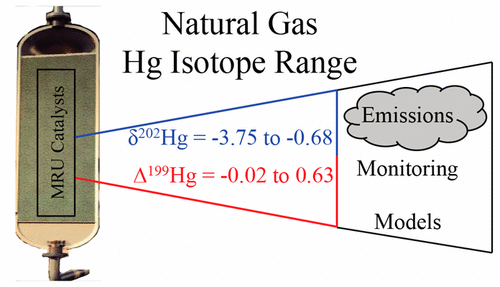当前位置:
X-MOL 学术
›
ACS Earth Space Chem.
›
论文详情
Our official English website, www.x-mol.net, welcomes your
feedback! (Note: you will need to create a separate account there.)
Isotopic Characterization of Mercury in Natural Gas via Analysis of Mercury Removal Unit Catalysts
ACS Earth and Space Chemistry ( IF 2.9 ) Pub Date : 2017-12-21 00:00:00 , DOI: 10.1021/acsearthspacechem.7b00118 Spencer J. Washburn 1 , Joel D. Blum 1 , Marcus W. Johnson 1 , Jodie M. Tomes 2 , Peter J. Carnell 2
ACS Earth and Space Chemistry ( IF 2.9 ) Pub Date : 2017-12-21 00:00:00 , DOI: 10.1021/acsearthspacechem.7b00118 Spencer J. Washburn 1 , Joel D. Blum 1 , Marcus W. Johnson 1 , Jodie M. Tomes 2 , Peter J. Carnell 2
Affiliation

|
Natural gas (NG) represents an important and rapidly growing global energy source, and some commercially relevant reserves of NG are reported to contain mercury (Hg) at concentrations between 0.01 and 5,000 μg/m3. The overall amount of Hg released to the atmosphere from gas production and combustion is largely unknown, but gaseous elemental Hg release is likely an increasing contribution to the global atmospheric Hg pool. However, no Hg isotopic compositions have been published for Hg entering the atmosphere from NG. In an effort to characterize the isotopic composition of Hg released from NG, we analyzed the stable isotopic compositions of mercury removal unit (MRU) catalysts that were loaded with Hg from NG production and supplied by Johnson Matthey Inc. We suggest that the bulk of Hg adsorbed to catalysts near the inlet of each MRU reactor is representative of the Hg isotopic composition of the NG source. In different gas fields, values of δ202Hg and Δ199Hg range from −3.75 to −0.68‰ and −0.02 to 0.65‰, respectively. Analysis of four samples from different positions within a single MRU reactor demonstrates significant isotopic fractionation of a small fraction of Hg that is not removed at the entrance to the MRU. We suggest that this fractionation is due to sorption of Hg to the catalyst surface from the gas phase and that this process follows a Rayleigh fractionation model with ε ≈ −0.40‰. In total, these results suggest that Hg isotopic analysis may be a feasible monitoring tool for Hg emissions from NG production in some gas fields. With further analyses of NG from around the world, a global average isotopic composition of NG-hosted Hg could be estimated to characterize this input to atmospheric Hg isotope models.
中文翻译:

通过分析脱汞单元催化剂对天然气中的汞进行同位素表征
天然气(NG)代表着重要的且正在快速增长的全球能源,据报道,一些与商业相关的NG储量中的汞(Hg)浓度在0.01至5,000μg/ m 3之间。。气体产生和燃烧释放到大气中的汞总量尚不清楚,但是气态元素汞的释放可能对全球大气汞池的贡献增加。但是,没有汞从天然气进入大气的汞同位素组成。为了表征从NG释放的Hg的同位素组成,我们分析了由约翰逊·马修(Johnson Matthey Inc.)提供并装载了NG生产中的Hg的除汞单元(MRU)催化剂的稳定同位素组成。吸附在每个MRU反应器入口附近的催化剂上的气体代表了NG源的Hg同位素组成。在不同的天然气田,δ值202 Hg和Δ 199汞的范围分别为-3.75至-0.68‰和-0.02至0.65‰。对单个MRU反应器中不同位置的四个样品的分析表明,在MRU入口处未除去的一小部分Hg具有明显的同位素分馏作用。我们认为这种分馏是由于Hg从气相吸附到催化剂表面,并且该过程遵循ε≈-0.40‰的瑞利分馏模型。总的来说,这些结果表明,汞同位素分析可能是某些气田天然气生产中汞排放的可行监测工具。通过对来自世界各地的NG的进一步分析,可以估算NG承载的Hg的全球平均同位素组成,以表征对大气Hg同位素模型的输入。
更新日期:2017-12-21
中文翻译:

通过分析脱汞单元催化剂对天然气中的汞进行同位素表征
天然气(NG)代表着重要的且正在快速增长的全球能源,据报道,一些与商业相关的NG储量中的汞(Hg)浓度在0.01至5,000μg/ m 3之间。。气体产生和燃烧释放到大气中的汞总量尚不清楚,但是气态元素汞的释放可能对全球大气汞池的贡献增加。但是,没有汞从天然气进入大气的汞同位素组成。为了表征从NG释放的Hg的同位素组成,我们分析了由约翰逊·马修(Johnson Matthey Inc.)提供并装载了NG生产中的Hg的除汞单元(MRU)催化剂的稳定同位素组成。吸附在每个MRU反应器入口附近的催化剂上的气体代表了NG源的Hg同位素组成。在不同的天然气田,δ值202 Hg和Δ 199汞的范围分别为-3.75至-0.68‰和-0.02至0.65‰。对单个MRU反应器中不同位置的四个样品的分析表明,在MRU入口处未除去的一小部分Hg具有明显的同位素分馏作用。我们认为这种分馏是由于Hg从气相吸附到催化剂表面,并且该过程遵循ε≈-0.40‰的瑞利分馏模型。总的来说,这些结果表明,汞同位素分析可能是某些气田天然气生产中汞排放的可行监测工具。通过对来自世界各地的NG的进一步分析,可以估算NG承载的Hg的全球平均同位素组成,以表征对大气Hg同位素模型的输入。











































 京公网安备 11010802027423号
京公网安备 11010802027423号